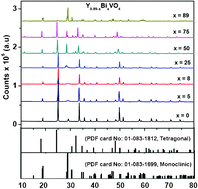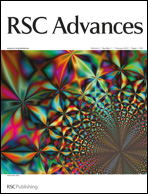Selective reduction of visible upconversion emissions induced by Bi3+ in Tm3+/Yb3+-doped Y0.89−xBixVO4 microcrystals†
Abstract
In this article we have shown that the intensity ratio of near infrared (NIR) to blue upconversion emission from Tm3+ ions can be enhanced up to 800 times by simple control of the concentrations of Bi3+/Y3+ in Tm3+(0.01)/Yb3+(0.10)-doped Y0.89−xBixVO4 (x = 0 to 0.89) microcrystals. The intensity of the strong blue emission occurring near 475 nm due to the 1G4→3H6 transition is selectively reduced upon bismuth doping, while the intensity of the NIR emission at 800 nm (3H4→3H6) is hardly affected. The enhanced NIR/blue emission intensity achieved via the upconversion process is advantageous in reducing the background scattering, and consequently increases the contrast in the bio-imaging applications. Several control experiments were performed to unravel the role of Bi3+ ions in the reduction of the blue emission intensity. An energy transfer mechanism involving Tm3+, Bi3+ and Yb3+ ions is proposed for the preferential reduction in intensity of the blue emission. All microcrystal samples were completely characterized using


 Please wait while we load your content...
Please wait while we load your content...